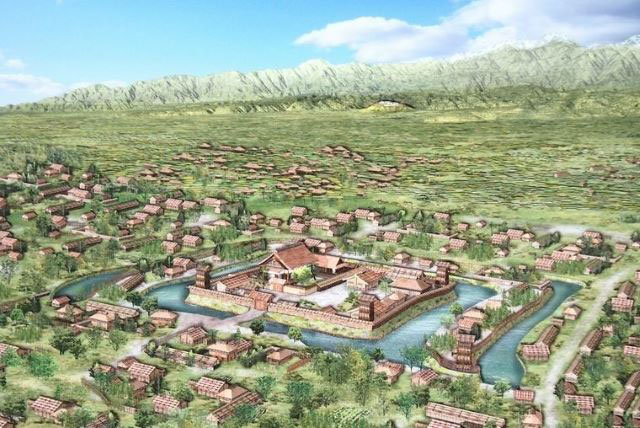
In 1335, the Shiina clan built Uozu Castle as an auxiliary stronghold supporting Matsukura Castle. By 1570, it had fallen under the control of the Uesugi clan, rapidly emerging as a strategic fortress in Etchū Province. For many years, Kawada Nagataka served as its commander.
Following the death of the renowned daimyo Uesugi Kenshin in 1578, his domain plunged into a prolonged civil conflict known as the Otate no Ran. Seizing the opportunity, Oda Nobunaga dispatched his top generals—Shibata Katsuie and Sassa Narimasa—from the Hokuriku region toward Etchū’s borders.
By 1581, Oda’s forces captured Toyama Castle and advanced into Etchū. Katsuie and Narimasa systematically expelled both Uesugi’s retainers and remaining Ikkō-ikki forces. Realizing the severity of the threat, Uesugi Kagekatsu (1556–1623), Kenshin’s heir, hurriedly reinforced Uozu Castle with trusted vassals.
By March 1582, combined Oda armies under Shibata, Sassa, Maeda Toshiie, and Sakuma Morimasa had attacked both Matsukura and Uozu. Approximately 10,000 besiegers confronted around 4,000 defenders at Uozu.
Unlike the mountain-stronghold of Matsukura, Uozu was a flatland castle (hirajō) near Toyama Bay, featuring two defensive lines: the central hommaru and an outer ninomaru. The hommaru was a near-square enclosure surrounded by a water moat with a single bridge at the entrance. The ninomaru corked around three sides in a “U” shape and also had its own moat. The castle lacked stone walls, yagura towers, or a donjon—instead, it relied on earthen ramparts (dorui) topped with clay walls (dobei), and watchtowers at each corner of the hommaru.
When Oda’s army appeared, the castle’s commanders sent an urgent plea to Kagekatsu. However, internal Uesugi strife, betrayal by Shibata Shigeie, and threats in Kaga and Shinano caused a delay. Meanwhile, Oda’s forces wore down the defenders with constant assaults.
In early May, Kagekatsu himself departed from Kasugayama Castle, captured the strategic Tenjin Hill, but failed to break the siege. Upon hearing news of a possible attack on Kasugayama, he withdrew. Left unsupported and starved of supplies, the Uozu garrison rapidly deteriorated.
After nearly three months of siege, in early June, thirteen senior Uesugi commanders chose to commit seppuku rather than surrender, and Uozu Castle fell. Oda’s forces had planned to advance into Echigo, but news of Nobunaga’s death in the Honnō-ji Incident sparked panic. Many commanders ordered a retreat from Etchū, and Uozu returned to Uesugi control without further fighting.
See also
-
The Siege of Hara Castle

The Shimabara Rebellion of 1637–1638, which culminated in the siege of Hara Castle, was the last major uprising of the Edo period and had serious political consequences.
-
Battle of Tennoji

The confrontation between Tokugawa Ieyasu and Toyotomi Hideyori during the “Osaka Winter Campaign” ended with the signing of a peace treaty. On January 22, 1615, the day after the treaty was signed, Ieyasu pretended to disband his army. In reality, this meant that the Shimazu forces withdrew to the nearest port. On the same day, almost the entire Tokugawa army began filling in the outer moat.
-
Siege of Shuri Castle

The Ryukyu Kingdom was established in 1429 on Okinawa, the largest island of the Ryukyu (Nansei) archipelago, as a result of the military unification of three rival kingdoms. In the following years, the state's control spread to all the islands of the archipelago.
-
The Siege of Fushimi Castle

Fushimi can perhaps be considered one of the most “unfortunate” castles of the Sengoku Jidai period. The original castle was built by Toyotomi Hideyoshi in the southeast of Kyoto in 1594 as his residence in the imperial city.
-
The Siege of Otsu Castle

The siege of Otsu Castle was part of the Sekigahara campaign, during which the so-called Eastern Coalition, led by Tokugawa Ieyasu, fought against the Western Coalition, led by Ishida Mitsunari. Otsu Castle was built in 1586 by order of Toyotomi Hideyoshi near the capital Kyoto, on the site of the dismantled Sakamoto Castle. It belonged to the type of “water castles” — mizujō — as one side of it faced Japan's largest lake, Lake Biwa, and it was surrounded by a system of moats filled with lake water, which made the fortress resemble an island.
-
The Siege of Shiroishi Castle

The siege of Shiroishi Castle was part of the Sekigahara campaign and took place several months before the decisive battle of Sekigahara. The daimyo of Aizu Province, Uesugi Kagekatsu, posed a serious threat to Tokugawa Ieyasu's plans to defeat the Western Coalition, and Ieyasu decided to curb his actions with the help of his northern vassals. To this end, he ordered Date Masamune to invade the province of Aizu and capture Shiroishi Castle.
-
The Second Siege of Jinju Castle

During the two Korean campaigns of the 16th century, the Japanese repeatedly had to capture enemy fortresses and defend occupied or constructed fortifications from the combined Korean and Chinese forces. Among all the operations of that time, the second siege of Jinju Castle is considered the most interesting from the point of view of siege warfare.
-
The Siege of Takamatsu Castle

The siege of Takamatsu Castle in Bitchu Province is considered the first mizuzeme, or “water siege,” in Japanese history. Until then, such an original tactic had never been used.

